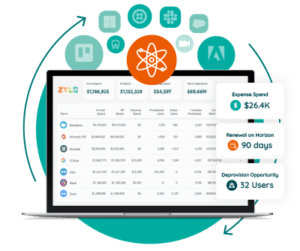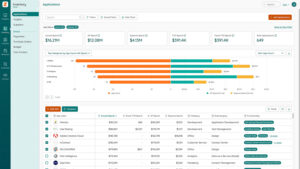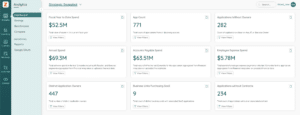
Zylo Wrapped 2025: SaaS Spend, AI Impact, and What’s Next
Table of Contents ToggleKey Themes That Shaped SaaS Management in 20251....
Back
Back
Search for Keywords...
Blog

Table of Contents
Updated November 4, 2025 — Revised to include the current state of SaaS spend and waste, KPIs to measure and report on, and tools to support SaaS spend reduction.
As budgets tighten and software stacks expand, organizations must rethink how they manage and reduce SaaS costs. For CIOs and CFOs, the goal is clear: gain visibility, eliminate waste, and reinvest savings into the business.
Despite investing millions of dollars in SaaS each year, a significant portion is wasted. From redundant tools and unused licenses to duplicate contracts and superfluous expense spend.
In this article, you’ll learn:
In 2025, global SaaS budgets exploded alongside the rise of AI-powered tools and remote collaboration.
SaaS spend continues to grow with no signs of slowing down any time soon. Companies continue to invest in cloud-based software; however, portfolios are quickly outpacing budget oversight.
As a result, cost visibility is more important than ever to reduce SaaS spend. Small inefficiencies, such as duplicate licenses or inactive users, can compound into significant waste at scale. As organizations layer AI tools on top of existing stacks, renewal cycles shorten and budgets tighten, making proactive management essential.
Beyond just controlling costs, optimizing SaaS investments enables better forecasting, aligns budgets with usage, and creates room to fund innovation without expanding total IT spend.

SaaS spend management means tracking and controlling the cost of every software subscription across your organization. It’s about knowing:
Optimization takes this further by analyzing usage data to consolidate tools, reduce waste, and negotiate better pricing. When spend is managed strategically, every license and contract contributes measurable business impact.
With SaaS costs increasing into the foreseeable future, organizations must adopt a SaaS spend management strategy. Doing so can help you:
If you’re struggling to see where your software budget really goes, you’re not alone. Zylo’s 2025 SaaS Management Index found that 72% of SaaS spend occurs outside IT’s visibility, led by lines of business and individual employees. Without that oversight, costs grow faster than you can contain them.

In fact, rising SaaS expenses directly influence operational efficiency, profitability, and innovation capacity. As the second largest OpEx today, that level of investment demands a disciplined approach. SaaS spend management gives you the clarity to see which tools drive value and which quietly drain your budget.
Your only opportunity to save money on software is at renewal. With accurate spend and usage data in hand, you can:
This approach helps you cut unnecessary costs without limiting productivity. It frees up your budget for innovation, automation, and AI initiatives that move your business forward.
According to the 2025 SaaS Management Index, the average organization has 125 expensed applications in their portfolio—or shadow IT. With more than half (51%) of expensed software miscategorized and hidden in expense reports, you can’t manage what you can’t see.
SaaS spend management helps reduce shadow IT by:
Zylo’s annual report found that 65% of IT leaders reported unexpected SaaS charges driven by consumption-based or AI pricing models. Beyond portfolio growth, the rise of AI and pricing model changes highlight an increasing challenge in forecasting spend.
With centralized contract and spending data, you can:
While a streamlined SaaS stack can save you money, it also helps your teams work smarter. When teams share integrated tools instead of juggling multiple platforms, data moves faster, collaboration improves, and everyone spends less time context switching between apps.
Zylo’s 2025 SaaS Management Index found that most organizations underestimate their SaaS spend and portfolio size by nearly 3X and 2X, respectively. Without a clear view, hidden costs multiply and your budget gets tied up in tools that don’t deliver results.
Organizations commonly waste SaaS spend in the following ways.
Recognizing these waste patterns is the first step toward taking control of your SaaS spend. Each one represents an opportunity to cut costs, tighten governance, and redirect resources toward more impactful initiatives.
“You’ve got a problem. You just don’t know that it’s a problem yet.”
On average, 53% of licenses go unused each month, representing $21M in wasted spend per organization annually. Employees change roles, projects shift, and some tools simply fall out of use. Without consistent oversight, these tools continue to drive up costs.

In 2025, shadow IT continues to be a source of wasted spending, and now shadow AI exacerbates the challenge. Without visibility into all spend, costs rise unnecessarily. Even more critical, your organization becomes vulnerable to data security risks, which include their own cost implications.
Vendors often rely on automatic renewals to retain revenue, which can quietly inflate your costs. If renewals slip through without review, you may end up paying for tools you no longer use or need.
For example, imagine you have a platform that costs $20,000 a year but sees little activity. Letting it auto-renew means that money is tied up for another year when canceling it would have allowed you to reallocate it elsewhere.
Many organizations overbuy licenses or consumption units “just in case.” While that may seem like a safe move, oversized contracts can lock you into paying for capacity you never use.
It’s common for different departments to buy similar tools without realizing it. For example, Marketing uses Asana while the Product team uses Trello. An excessive amount of redundant tools quickly drain your budget and inflate spending.
Even great software can fail to deliver value if your team doesn’t use it. Low adoption usually points to issues with onboarding, communication, or fit. When poor-fit apps stay in your stack, they contribute to unnecessary spending.
Another common source of SaaS spend waste is duplicate subscriptions, which evade detection through decentralized purchasing. One team might buy a tool ad hoc that was already purchased under an enterprise agreement.
Reducing SaaS costs starts with clear visibility and grows into an ongoing discipline. By following these steps, you can uncover hidden waste, streamline renewals, and build a software strategy that protects your budget while supporting innovation.
Each step builds toward lasting efficiency, giving you a clearer view of your software ecosystem and the confidence to make smarter, faster spending decisions.
 Start by identifying every SaaS application your organization uses, not just those purchased by IT. Check:
Start by identifying every SaaS application your organization uses, not just those purchased by IT. Check:
Zylo’s 2025 SaaS Management Index found that the average enterprise manages over 300 SaaS apps, with nearly half acquired outside IT oversight. Building a complete inventory helps uncover immediate opportunities to consolidate or cancel unused tools.
How the Zylo Discovery Engine Powers the Most Comprehensive SaaS Management Platform
Learn MoreOnce you know what’s in use, centralize that information. A SaaS system of record should include:
When finance, IT, and Procurement teams share a single source of truth, decisions are made faster and duplicate purchases stop slipping through.
To maintain control, create a consistent operational framework. A dedicated SaaS operations (SaaSOps) function can:
This structure turns SaaS Management into an ongoing process that creates a cost savings pipeline for your business.
ON DEMAND: SaaS Operations: Driving Cost Savings at Scale
Learn MoreDefine clear rules for how new software is purchased. Your policy should outline:
Standardized processes for software acquisition helps prevent unnecessary spending, overlapping tools and shadow IT.
Focus optimization on your most expensive vendors first, such as CRM, analytics, or collaboration tools. Follow these steps:
Unused and underutilized licenses are often the biggest source of waste. To cut costs:
Even modest reductions can save substantial money while maintaining productivity.
“Start with the low-hanging fruit. Visibility into unused licenses and duplicate apps delivers immediate savings—often before you’ve even finished your first full audit.”
— Daniel Garcia, former IT Sourcing and SAM at Coinbase
Compare tools with overlapping functionality and decide which delivers the most value. Consider:
Consolidating redundant platforms reduces complexity, support costs, and confusion across teams.
Go into every renewal with pricing intelligence. Use pricing benchmarks to:
Guide to Managing SaaS Costs
Learn MoreA SaaS Management Platform (SMP) provides the tools and data to maintain long-term savings and control. The following capabilities make the biggest impact:
Understanding your SaaS environment begins with comprehensive, always-on discovery. With Zylo’s AI-powered discovery model, you uncover all of your SaaS apps and spending—even those hidden in expense reports.
Because discovery is ongoing, new software and spend is detected as they enter your environment. As a result, your SaaS system of record stays up-to-date, ensuring data is accurate for decision making.

“Visibility into our portfolio was table stakes for the success of our program.”
— Vinod Vishwan, Sr. Director, Head of Business Planning & Operations, Adobe
SaaS operations (SaaSOps) teams rely on data integrity and automation to manage renewals strategically. Using an SMP helps you:

Reporting on SaaS spend reduction is critical to secure ongoing support of your initiatives. Many SMPs include built-in dashboards and reporting, enabling you to track license reclamation, vendor consolidation, and negotiation outcomes over time. Ensure visibility across teams and illustrate business impact regularly by automating this information to key stakeholders.

When it comes to measuring SaaS spend optimization, there are several essential KPIs to track:
By tracking these indicators, you can:
Both cost savings and cost avoidance contribute to a healthier SaaS strategy, but they represent different types of impact.
ModMed Drives Operational Excellence & Million-Dollar Savings with Zylo SaaS License Management
Discover how ModMed used Zylo’s powerful license tracking and optimization to save millions of dollars, drive operational excellence, and improve the employee experience.
Modernizing Medicine (ModMed) provides a clear example of how focused SaaS Management helps reduce costs. The company partnered with Zylo to gain visibility into its software stack and improve renewal efficiency.
By tracking savings and progress against key KPIs, ModMed turned SaaS Management into a strategic advantage. It’s proof that the right metrics can transform oversight into long-term value.
“Prior to Zylo, getting data on application types, licenses, and users was a manual process that would take hours, even days.”
As you seek to reduce SaaS costs, a repeatable checklist helps you stay proactive. Use this checklist to guide quarterly reviews, track renewals, and keep your software aligned with business goals.
To put this checklist into practice,
By treating this checklist as an ongoing rhythm, you’ll continue to find savings, strengthen data visibility, and empower your teams to innovate without waste.
Optimizing your SaaS portfolio doesn’t stop once you find savings. It’s an ongoing process of discovery, data management, and renewal discipline. The right tools make that process easier, more transparent, and more effective.
Zylo’s SaaS Spend Management and Renewals solution gives you the visibility and control you need to keep costs down. With a single platform, you can:
When you have full visibility into your SaaS ecosystem, you can move faster, plan smarter, and invest confidently in the technology that drives growth.
Ready to turn SaaS spend management into a strategic advantage? Request a demo to see how Zylo helps you reduce costs, eliminate waste, and maximize the value of every software investment.
According to Gartner, global spending on SaaS is projected to reach $299B in 2025, up nearly 20% from last year. The Zylo 2025 SaaS Management Index reports the average organization spends $49M annually and $4,830 per employee. These costs quickly rise when purchasing and usage go unchecked.
The biggest culprits include unused licenses, redundant apps, and automatic renewals that go unnoticed. Many organizations also lose money through shadow IT purchases and oversized contracts that exceed real demand.
Start by gaining visibility into all tools, usage, and renewals. From there, centralize data in a system of record, enforce purchase policies, and review high-cost apps. Reducing license waste and consolidating redundant tools can realize substantial savings without affecting productivity.
Usage data is your best source of truth. Pull reports from your SaaS Management Platform or vendor dashboards to see who’s logging in, how often, and for how long. Licenses with little or no activity should be reclaimed, downgraded, or reassigned.
Look for multiple tools performing the same function. Meet with department leads to compare feature needs and usage patterns, then standardize on the platform that offers the best value and adoption. Consolidation streamlines collaboration and simplifies support.
Start negotiations at least 90 days before renewal. This window gives you leverage to review usage data, reclaim unused licenses, benchmark pricing, and explore competitive alternatives before a contract auto-renews.
Key metrics include total SaaS spend over time, license utilization rate, reduction in redundant apps, and cost savings from canceled contracts or price reductions. Tracking these KPIs quarterly keeps savings visible and measurable.
Set renewal alerts, maintain a shared calendar, and require vendor reviews before payment approval. A centralized system of record like Zylo automatically flags upcoming renewals so you never pay for tools you don’t need. Prevent auto-renewals altogether by asking vendors to remove the clause from your agreement.
Yes. While SaaS spend management is possible manually, a SaaS Management Platform makes it far easier to manage hundreds of apps. It automates discovery, usage analysis, and renewal workflows, saving time while increasing accuracy.
Treat SaaS optimization as a continuous process. Schedule quarterly audits, track key metrics, and regularly update purchasing policies. With consistent oversight, you’ll reduce waste year round and build a scalable, data-driven approach to managing software costs.

Table of Contents ToggleKey Themes That Shaped SaaS Management in 20251....

Table of Contents ToggleHow Big SaaS Spending Has Become in 2025What...

Table of Contents ToggleHow Big SaaS Spending Has Become in 2025What...

Table of Contents ToggleHow Big SaaS Spending Has Become in 2025What...
| Cookie | Duration | Description |
|---|---|---|
| cookielawinfo-checkbox-analytics | 11 months | This cookie is set by GDPR Cookie Consent plugin. The cookie is used to store the user consent for the cookies in the category "Analytics". |
| cookielawinfo-checkbox-functional | 11 months | The cookie is set by GDPR cookie consent to record the user consent for the cookies in the category "Functional". |
| cookielawinfo-checkbox-necessary | 11 months | This cookie is set by GDPR Cookie Consent plugin. The cookies is used to store the user consent for the cookies in the category "Necessary". |
| cookielawinfo-checkbox-others | 11 months | This cookie is set by GDPR Cookie Consent plugin. The cookie is used to store the user consent for the cookies in the category "Other. |
| cookielawinfo-checkbox-performance | 11 months | This cookie is set by GDPR Cookie Consent plugin. The cookie is used to store the user consent for the cookies in the category "Performance". |
| viewed_cookie_policy | 11 months | The cookie is set by the GDPR Cookie Consent plugin and is used to store whether or not user has consented to the use of cookies. It does not store any personal data. |
